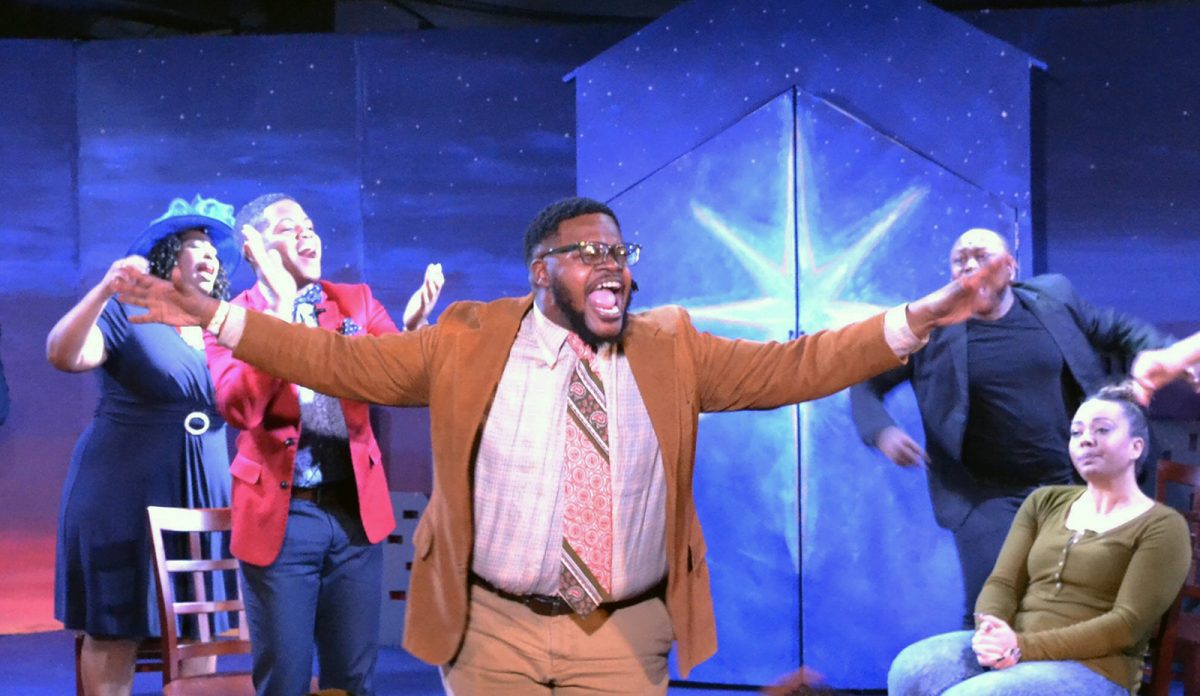
ArtsCentric’s latest production, Black Nativity, will have you rockin’ and rollin’ in your seat during its run at the Motor House’s black box theater.
At a packed crowd during a Saturday matinee, there wasn’t a soul in the audience who wasn’t stomping their feet, clapping along, and, in some cases, singing. Some even got out of their seats to sway along during this Christmas musical of folk, blues, soul, jazz, and African-American spirituals. The show runs through December 29.
This retelling of the nativity story features an all-black cast and pairs the poetry of Langston Hughes with original musical adaptations that change with each newly launched production. The original music produced by each new theater troupe ensures a unique listening experience based on each troupe’s musical direction, instrumentation, and vocalists. ArtsCentric’s show features the original music of Cedric D. Lyles, performed by a live band—with piano, keys, electric guitar, bass, and drums—behind the set. Some of the songs are new takes on Christmas classics, such as “The Drummer’s Song,” a spinoff of “The Little Drummer Boy” that includes a bongo drum.
The production is an ideal one for ArtsCentric, a self-described color-conscious organization that was founded in 2003.
The play, directed by Kevin S. McAllister, is based on the Gospel of Luke and begins with a young boy singing “Oh Come, All Ye Faithful” on the street, panhandling for change. Several people pass by, dropping money into his bucket and continuing about their day, until a large, white-winged angel appears on set, nudging one last onlooker to give the boy what he really needs: a scarf to keep warm, company during the holidays—in short, love.
Then a full choir enters the stage, donning robes and setting the lively tone for the rest of the play. The chorus of singers lights up the space with song and gives an overview of what’s to come.
Next, we see a shift in time, as the 20-some actors are costumed in traditional African garb—loose robes in African-print patterns and sequins, which adds another dimension to the rich cultural fabric brought to the stage. Act I follows the story of Mary and Joseph, as they prepare for the birth of baby Jesus, give birth, debate on a name, and ultimately celebrate the coming of the savior.
After a short intermission, Act II transports its audience back to the 21st century. Set inside a black church, testimonials about a Christian life are interspersed with soulful renditions of contemporary worship pieces sung energetically, from the poetic to the funky, with songs like The Staple Singers’ famous “I’ll Take You There” (that one really got the crowd moving).
All the while, the young boy in the first scene wanders through the set, taking in each song with innocent eyes and watching the story unfold.
“It shows how belief in the nativity story has actually changed lives,” McAllister says in a release. “It sends a message of hope, endurance, and acceptance, in the spirit of the African griot tradition passed down through generations.”
While Black Nativity is certainly theatrical—with a narrative that moves through the birth of the Christ child and then into the 21st-century aftermath—it also plays out like an epic poem come to life: less musical and more gospel choir performance, with very little dialogue between its roughly two dozen songs. We have the legendary Hughes to thank for that, but also the strong, surging voices of the ArtsCentric vocalists, who give mind-blowing performances.
In the end of the play, as in its beginning, the message resonates: that Jesus is love, and love can save you. And more than 50 years after Black Nativity’s initial run, it’s just as timeless a message as ever.
